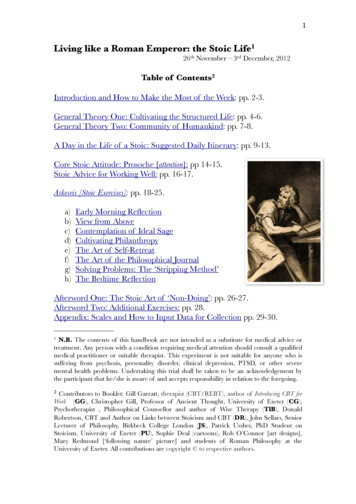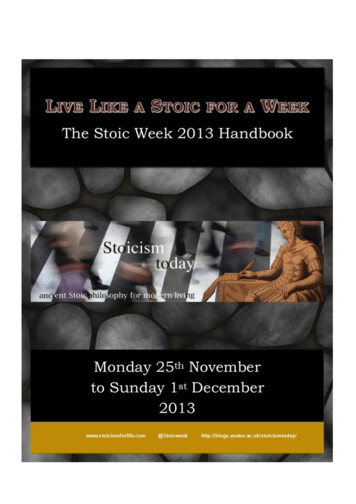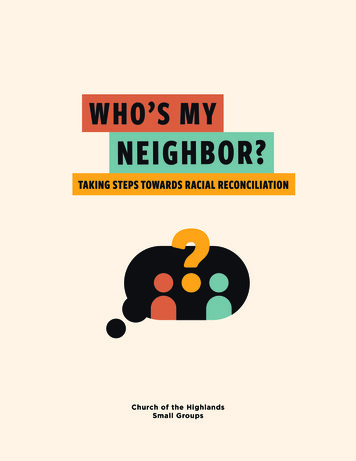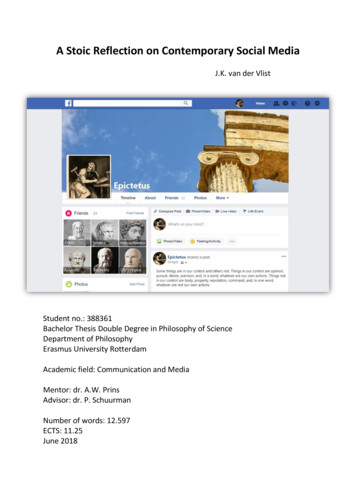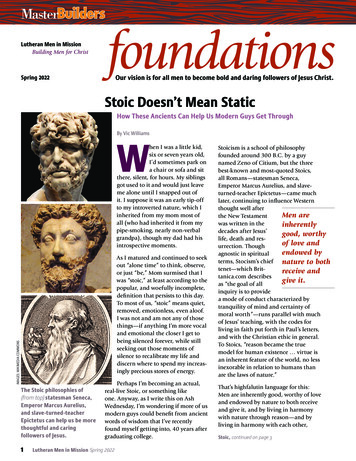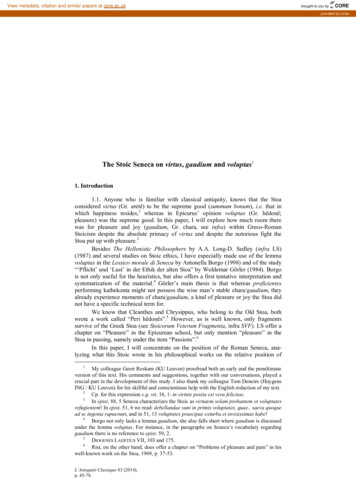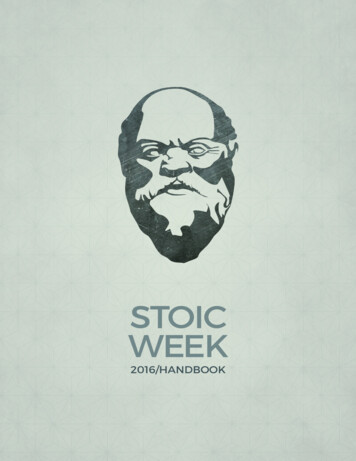
Transcription
The Stoic Week 2016 HandbookStoicism & LoveNo school has more goodness and gentleness; none has more love for humanbeings, nor more attention to the common good. The goal which it assigns to us is tobe useful, to help others, and to take care, not only of ourselves, but of everyone ingeneral and of each one in particular. (Seneca, On Clemency, 3.3)Latest Revision: 25th September 2016
ContentsIntroductionWhat is Stoicism?Stoic Week: Your Daily RoutineThe Stoic Self-Monitoring RecordMonday: LifeTuesday: ControlWednesday: MindfulnessThursday: VirtueFriday: RelationshipsSaturday: ResilienceSunday: NatureAfter Stoic WeekAppendix: Further ReadingCopyright Notice & Terms of UseCopyright Christopher Gill, Patrick Ussher, John Sellars, Tim Lebon, Jules Evans, Gill Garratt, and Donald Robertson,2014-2016. All rights reserved. All images copyright Rocio De Torres, reproduced with permission.The contents of this handbook are not intended as a substitute for medical advice or treatment. Any person with acondition requiring medical attention should consult a qualified medical practitioner or suitable therapist. This experimentis not suitable for anyone who is suffering from psychosis, personality disorder, clinical depression, PTSD, or othersevere mental health problems. Undertaking this trial shall be taken to be an acknowledgement by the participant thatthey are aware of and accept responsibility in relation to the foregoing.
Introduction to Stoic WeekWelcome to this year’s Stoic Week! Stoic Week is an annual online event in which peoplefrom all over the world attempt to live like a Stoic for seven days. This is your opportunityto take part in a unique experiment: following ancient Stoic Philosophy as an aid to livingin the modern world, using this handbook as your guide. The handbook was developed byour “Stoicism Today” group, which was formed in 2012. We are a multi-disciplinary team ofacademic philosophers, classicists, professional psychologists and cognitive therapists,with a special interest in applying Stoic concepts and practices to the challenges ofmodern living. The group includes several authors known for their writing and research onStoicism. (You can find out more about us on the Stoicism Today website.) For those ofyou interested, there is also a longer and more intensive version of Stoic Week calledStoic Mindfulness and Resilience Training (SMRT), designed by Donald Robertson, whichruns every year, lasting four weeks.In 2015, Stoic Week proved extremely popular, with over 3,200 people participating. Youcan read the Stoic Week 2015 Report online. Each year we receive a huge amount ofonline feedback from participants, which we use to revise and improve the handbook.In this handbook, you will find advice on how to adapt and follow Stoic principles, with acombination of general theory and more specific, step-by-step guidance on certain Stoicexercises. These materials have been prepared by experts in the field and give you anunusual and completely free-of-charge opportunity for personal development.This Year’s Theme: Stoicism and LoveThe theme for this year’s Stoic Week is Stoicism and Love. Many people mistakenlybelieve that Stoicism is unemotional. However, as we’ll see, the Stoics made a point oflisting positive and healthy emotions experienced by what they would call the ‘ideal wiseman’. In particular, love plays a fundamental role in Stoic Ethics: for example, MarcusAurelius said that his goal was to be free from irrational passions, and yet full of love.Frequently-Asked QuestionsQ: How do I know that living like a Stoic will benefit me?A: You can’t know for certain until you try. Indeed, one of the reasons we’re conducting theexperiment is to find out whether, and how, Stoic practices can help us to live better lives.Having said that, in previous years, our participants have consistently reported benefits.For example, in 2015 our research findings showed that, on average, life satisfactionincreased by 15%, flourishing by 10%, positive emotions by 10%, and there was a 14%
reduction in negative emotions. Data collected from the SMRT course showed that whenwe extended the exercises to four weeks, life satisfaction increased by 27%, and negativeemotions decreased by 23%.The benefit for you may be educational or philosophical, if it helps you to understand whatStoicism means. It may be psychological, helping you to become more resilient andpossibly even happier. It may be moral, and you may find that the week helps you developcertain ethical qualities. Some people may, of course, find that Stoicism just isn’t for them,which might in itself be a valuable discovery. However, from the questionnaire data we’vecollected and previous participants’ testimonies we can see that most people whoparticipated in Stoic Week and related events found their experiences very enjoyable andbeneficial.Q: What’s the basic idea?A: You need to do the following:1. Complete the online questionnaires at the beginning and end of Stoic Week.2. Follow the daily schedule, consisting of a passage for reflection and Stoic meditationsfor the morning and evening. At lunchtime, or another time more suitable for you,consider the Stoic exercise for that day.You should read each chapter in advance of the corresponding day. You might choose toread Monday’s chapter, for example, first thing on Monday morning, or beforehand onSunday evening. Some people may find it easier just to read the whole handbook throughbefore beginning Stoic Week, though, and use the summary in each chapter as a dailyreminder.You’ll find a convenient summary of your daily routine at the end of this introductorysection of the handbook, and additional summaries in each daily section to help youremember what you’re supposed to be doing. The morning and evening meditationpractices will also provide you with a simple daily routine or structure to help you to reflecton what you’ve done each day and what happened to you. Instructions for the Stoicmeditations are offered in this booklet, but there are also guided audio exercises if youwish to use them. You can download these from the page below:MP3 Audio Recordings for Stoic WeekYou’ll begin by learning to record your thoughts, actions, and feelings, and to startobserving them in a more detached and “philosophical” way. One of the main strategiesthat runs through both Stoicism and this handbook is that of distinguishing between thingsthat are under your control and things that are not. The Stoics believed that this takestraining to do well but that it’s the key to self-discipline and overcoming emotionaldisturbances. Maintaining this distinction requires continual attention to your own thoughtsand judgements, which we can describe as a kind of ‘mindfulness’ practice. You’ll then
build upon this foundation by exploring different Stoic concepts and techniques each daythroughout the course of the week.Q: I’m worried I may not have time to do everything, so how can I givemyself the best chance of making the most of it?A: It will probably be helpful for you to think of this as a definite, short-term commitment –similar perhaps to the effort you would put into rehearsing the week before appearing in aplay, or an exam, or training for a sporting event. Ideally this might take about 15 minutesin the morning and evening, and the same at midday, although you might want to spendmore or less time on the exercises. Some people have told us they can only spare five orten minutes, which is absolutely fine. However, data from previous participants in StoicWeek showed the average amount of time they spent on the course was precisely 36minutes per day. (This is very similar to the commitment required for most researchstudies on psychological self-help or skills training.)Q: How can I make use of modern technology for Stoic Week?Here are some ideas:Video. Record a video diary of your experiences of living like a Stoic and publish onYouTube or another video-sharing siteBlogging. Blog about your experiences on your own site, or send them to ourWordPress blog: Stoicism TodayTwitter. Tweet about your experiences, or post Stoic adages on Twitter as you goalong, using #stoicweekFacebook. Discuss ideas or raise questions on our Facebook Stoicism group toshare your ideas and experiencesGoogle . You may also want to share your thoughts on our Google community pageMobile. Use your phone to set reminders to start your Stoic practicesOther Social Media. Although, we don’t currently use other social networks likeInstgram and Snapchat, there’s nothing to stop you from doing so as part of StoicWeek.There are also Stoic groups on LinkedIn and Reddit, which you may find usefulWhich of these appeal to you? How many other ways can you use technology to help youlive like a Stoic? If you are doing the experiment with other people it might help to discussyour experiences regularly. Perhaps you could have a 10 minute Stoic coffee break eachday where you touch base with others to discuss how you are doing.Q: Can I take part offline or by using my mobile device?A: Absolutely. We provide ebook versions of the Stoic Week handbook, which can be used
offline on mobile phones, tablets, and e-readers. This can be very useful if you’re travellingand won’t always have internet access. There are three ebook file formats provided: MOBIfor Amazon Kindle devices, EPUB for use on all other e-readers and Android and AppleiOS devices, and PDF files, which can be printed or read on virtually any device. Werecommend using the MOBI or EPUB formats for reading on electronic devices and thePDF format for printing. (You can also open all three formats on your computer, if you havethe appropriate software installed.) We also recommend that at the start of Stoic Week youbegin by downloading all of the available offline formats, just in case you need them. Youcould also print a hard-copy from the PDF file, which is generally the best format to use forthis purpose. Most people with internet access work through the handbook on our mainwebsite.Q: What if I have problems?A: We’re here to provide help and support. Just email the course administrator viaadmin@modernstoicism.com or use the contact form on the main website. Many hundredsof people have successfully used all of these resources, readings, and exercises sinceStoic Week began in 2012 so we know they’re definitely usable, although individuals dosometimes inevitably experience technical problems or have other issues that they needhelp with. Your first lesson in Stoicism may be that, rather than give up when you run intoan obstacle, there’s usually a way forward if you’re willing to persevere and seek help fromthe right people.Q: How will I know whether it has helped or not?A: You will fill in questionnaires before and after the week which will help you to seeobjective measures of change and also allow you to reflect on the experience. Your doingso will also help us to evaluate the benefits and limitations of Stoic practices. In Stoicterms, you could even say that participation in the experiment can be seen as contributingtoward living a good life.
What is Stoicism?Stoicism is a school of ancient Greek philosophy in the Socratic tradition. It was founded inAthens by Zeno of Citium around 301 BC. The name comes from the painted porch (stoapoikile) where Zeno lectured his students. Stoicism later became very popular in ancientRome, where it continued to flourish long after the disappearance of the original Greekschool. Less than one percent of the Stoics’ original writings now survive, however. Themost important ancient sources that survive today are:1. The many Letters, Essays and Dialogues of the Roman statesman Seneca, who wasadvisor to the emperor Nero.2. The Handbook and four surviving books of Epictetus’ Discourses compiled from hislectures by a student called Arrian. Epictetus, a Greek ex-slave, is the only Stoicteacher whose thought survives in book form.3. The Meditations, a private Stoic notebook or diary of the Roman emperor MarcusAurelius, who was strongly influenced by Epictetus.In the Stoic Week Handbook we have included quotations from all three thinkers,especially Marcus Aurelius, who himself expresses Stoic ideas in a distinctively brief andeloquent form, which many people find very powerful. We think that Marcus wrote hisMeditations as morning or evening reflections to help provide philosophical support forhimself in an intensely busy and demanding life as emperor and general. (In the 17thcentury, Anthony Ashley-Cooper, the third Earl of Shaftesbury, wrote his own Stoic journalclosely based on The Meditations and Epictetus’ Discourses, available in print today asThe Philosophical Regimen.)Stoic Week gives you a chance to follow a similar routine to Marcus each day. You mightlike to write down your own morning and evening meditations and keep them in anotebook, or share them with other people through social networks. You can base yourpersonal meditations on the topics suggested or use other Stoic ideas that you have learntabout and find helpful.Some people choose to read Marcus’ Meditations during Stoic Week, although this isoptional. There are recent translations in paperback and e-book formats from OxfordWorld’s Classics and Penguin. Another translation of Books 1-6 of The Meditations(Oxford Univ. Press, 2013) provides a full introduction and commentary by Prof.Christopher Gill, one of the founders of Stoic Week. We hope that the Stoic WeekHandbook provides as much help and support to you as Marcus found by writing hisMeditations.Central Stoic IdeasWhat is Stoicism? How might it help us to live better, happier lives today? Some of you will
be drawn to this experiment because you already know a little bit about Stoicism and wantto put it into practice for yourselves. Others may know very little about Stoicism and arecurious to learn more. The ancient Stoic philosophical system was well known for beingvast and complex, addressing a wide range of topics under the headings of ethics, logic,and physics. It will be impossible to introduce it all but here are three central ideas at theheart of Stoic ethics:1. VirtueThe Stoics argued that the most important thing in life and the only thing with real value is‘virtue’, by which they meant excellence of character. The core virtues for the Stoics were:Wisdom, especially moral or practical wisdomJustice, encompassing both kindness and fairness, or wisdom applied to ourrelationshipsCourage or “fortitude”, i.e., mastery over our fearsModeration or “temperance”, i.e., mastery of our desiresWisdom is the most important virtue to Stoics and, all other virtues are seen as a form ofpractical wisdom. The virtues of courage and moderation are the forms of Stoic selfcontrol required to live consistently with wisdom and justice, especially when beset bychallenges from without and unruly desires and emotions from within. Epictetus’ famousslogan “endure and renounce” appears to refer to these two virtues of self-mastery.However, Stoic virtue needs to be understood quite broadly in terms of ethical principles,as well as having a good character and good attitudes toward other people. Virtue is notjust a matter of what’s going on in your head but also of what’s going on in your family andsocial relations, your intentions, your actions, and your pattern of life as a whole. Fromanother perspective, Stoic virtue refers to the perfection of our own nature, like an acorngrowing into an oak tree. We have the capacity for wisdom, and virtue consists in fulfillingthat potential within ourselves. Virtue ultimately entails living in accord with our own natureas rational beings, but also in harmony with the rest of mankind and in agreement withNature as a whole. In practice, that means facing difficult people and physical hardshipswith good grace, patience, and equanimity.The central Stoic claim was that virtue is ultimately the only thing that really matters; it isthe only thing that is truly good, and it is the only thing that can bring us well-being andfulfilment. Cultivating virtue ought to be our top priority, above all other things, if we want tolive a good life. The Stoics used the word eudaimonia to describe someone who lives thebest type of life. It’s usually translated as “happiness”. However, it doesn’t refer to a happyfeeling but rather something more rounded and complete. Some people think that“flourishing” or “fulfilment” are better translations. You can also think of eudaimonia asmeaning “happiness” in the archaic sense, the opposite of being in a “hapless” orwretched condition.
The Stoics also believed that we are naturally inclined to recognise the overriding value ofvirtue, and that we are born with an instinctive wish to benefit others and to express this insocial involvement. From this natural basis we may come to see the bond betweenourselves and all human beings. Conversely, the Stoics claimed that all those externalthings that people often pursue – a good job, money, success, fame, etc. – cannotguarantee us happiness. They could well be parts of a happy life but, on their own, theywill never deliver genuine fulfilment unless we also have the virtues. The Stoics refer toeverything “external” to our own character as “indifferent”, in terms of attaining the goodlife. This term causes some confusion but you could simply think of it as meaning “notworth getting upset about”. Some morally “indifferent” things are to be “preferred” or“rejected”. That is, they’re lightly sought or avoided with the reservation that the outcomeis never absolutely under our control. Hence, the Stoics said it is rational and indeed wisefor us to prefer having these things in life within reason. It is just that personal fulfilmentdepends ultimately on developing virtue rather than on having the opportunity to acquirethese external things, which is always partly in the hands of fate.2. EmotionsIn the popular imagination a Stoic is someone who denies or represses their emotions in apotentially unhealthy way, like a robot or Mister Spock from Star Trek. However, this isdefinitely a misconception, albeit a very widespread one. The central Stoic claim was thatour emotions are ultimately the product of the judgements that we make. It is because wethink external events are what ‘really matters’ that we feel anger or fear. As we get a betterunderstanding of what really matters, and what is ‘up to us’, then these unhealthy orirrational emotions will be replaced by healthy, rational ones. In short: as we developethically and as we see the absolute value of virtue, our emotional life will change for thebetter.In the same way that faulty value-judgements lead to unhealthy emotions and desires, sotoo will wise judgements lead to rational and healthy ones. For example, the Stoicsclaimed there were three broad categories of good desires and emotions that are part of ahappy and fulfilled life and which naturally follow as a consequence of developing virtuousattitudes:1. Joy or delight in the experience of what is truly good, as opposed to more vacuous ordestructive pleasures.2. Caution or discretion directed against the prospect of what is truly harmful to us, likefolly and vice, as opposed to the fear of external things in life.3. Wishing or willing what is truly good, such as (gently) desiring the well-being ofourselves and others, as opposed to irrational craving for things that are not entirely‘up to us’ like health, wealth, or reputation.As we’ve seen , Marcus Aurelius actually described the goal of Stoicism as becomingsomeone “free from passions and yet full of love”, by which he primarily means
overcoming unhealthy desires and emotions. So the Stoic Sage is not simply anemotionless, cold fish. In fact, the ancient Stoics repeatedly said their goal was not to beas unfeeling as someone with a heart of stone or iron. Rather, it was to develop the naturalaffection we have for those close to us in accordance with virtue, or if you prefer: to loveourselves and others, with wisdom. This ultimately means extending our ethical concern tohumankind in general by developing an attitude of philanthropy.It is a man’s especial privilege to love even those who stumble. And this love followsas soon as you reflect that they are akin to you and that they do wrong involuntarilyand through ignorance, and that within a little while both they and you will be dead;and this above all, that the man has done you no harm; for he has not made your“ruling faculty” worse than it was before. (Marcus Aurelius, Meditations, 7.22)The Stoics also acknowledged the existence of certain reflex-like aspects of emotion:physiological reactions, such as blushing, stammering, or being startled. These typicallyremain involuntary and beyond our direct control, although we can choose how werespond to them and whether we allow ourselves to dwell on or escalate our firstimpressions and initial reactions into full-blown “passions” of an excessive or unhealthysort. It’s one thing to be startled or taken by surprise, and another to continue needlesslydwelling on and worrying about unimportant things.3. Nature & the Community of HumankindThe founders of Stoicism said that the central doctrine of their philosophy – the goal of life– could be summed up as “living in agreement with Nature”. What did they mean by this?Well, we know that they thought it was synonymous with “living in accord with virtue”. Asyou learned earlier, the Stoics thought of Nature in at least three key ways:1. Our true inner nature, which they believed to consist in our capacity for reason2. The nature of society and our relationship with the rest of mankind3. The nature of our external environment as a whole the universe around usThe Stoics believed that leading a life with virtue as your goal is the natural way for ahuman being to live. They encourage us to see that if we create a wholeness andcoherence of moral character in ourselves, we are matching the coherence and unity thatthey see in the world as a whole. By contrast, the foolish and vicious person is perpetuallydivided from his own true nature, in conflict with other people, and alienated from the worldaround him.By contrast, the Stoics also encourage us to see ourselves as integral parts of nature andpart of a greater whole. Today, many human beings are aware that they need to thinkmore about the impact of human actions on the natural environment and to seethemselves within the context of nature. The Stoic worldview can help us develop thisattitude. For the Stoics, our life-cycle from birth to death is but one infinitesimal part of lifein nature, and realising this can help us accept every event, including our own death and
that of others, with equanimity. Taking a broader and more objective perspective on lifewas part of what the Stoics meant by studying Nature (“physics”), but it is also somethingthat can help transform our personality in a moral and therapeutic sense.As noted already, virtue is not just a matter of your state of mind but of how you relate toother people. The Stoics believe that most species of animals, and especially the humanspecies, are naturally sociable in character. We naturally form attachments and wenaturally live in communities. From this natural affection stems the Stoic ideal of the‘community of humankind’. As Marcus Aurelius writes:We were born for cooperation, like feet, like hands, like eyelids, like the rows of upperand lower teeth. So to work in opposition to one another is against nature: and angeror rejection is opposition. (Meditations, 2.1)If you are going to follow Stoic Week then you should attempt to be open toward Stoicismand these three central ideas about value, emotions, and nature. You don’t need to acceptthem uncritically but you do at least need to be prepared to explore them further andconsider whether they seem to you actually true, as well as potentially beneficial to you inhow you lead your life.Our aim in this project is not to try to convince you of the truth of these claims but simply tosee if they are helpful for you in the way you lead your life. If these key ideas seemcompletely absurd to you then it may be that Stoic Week is not the right experiment foryou.
Stoic Week: Your Daily RoutineEach day in Stoic Week has its own central theme, and these themes build upon oneanother as the week progresses, making the whole week, potentially, the beginning of adeeper journey into Stoicism. Take some time out at midday each day, or any time thatsuits you, to reflect on the day’s theme and how it might shape the various activities inwhich you are engaged.There are also morning and evening meditations, which you should try to practise at thebeginning and end of each day. Let’s now explore these two exercises in more detail.Morning MeditationWhen you wake up each morning take a few moments to compose yourself and thenpatiently rehearse the day ahead, planning how you can make yourself a better person,while also accepting that some things lie beyond your control.1. Marcus Aurelius talks about walking on your own to a quiet place at daybreak andmeditating upon the stars and the rising Sun to prepare for the day ahead. You canalso do this at home, sitting on the end of your bed, or standing in front of the mirror inyour bathroom, and still think of the sun rising against a backdrop of stars.2. Pick a specific philosophical principle that you want to rehearse and repeat it toyourself a few times before imagining how you could put it into practice during the restof the day. You might choose the key general Stoic theme: ‘Some things are underour control whereas others are not’ and to think about giving more importance tobeing a good person, acting well, and treating things you cannot control as ultimatelymuch less important.3. Alternatively, you might pick a specific virtue that you want to cultivate in order toprepare yourself mentally for your day ahead. For exampe, imagine in broad outlinehow you would act if you showed more wisdom, justice, courage, or moderation.4. Practise this meditation for about 5-10 minutes, picking out key events or specificchallenges that might arise.Once you’ve gotten into the habit of doing this try imagining greater challenges in the dayahead such as some of your plans not going as you hope or dealing with difficult people.As you consider a possible difficulty, think about how you could tackle it with a Stoicprinciple or virtue.Say to yourself at daybreak: I shall come across the meddling busy-body, theungrateful, the overbearing, the treacherous, the envious, and the antisocial. All this
has befallen them because they cannot tell good from evil. (Meditations, 2.1)Evening MeditationEpictetus and Seneca both allude to a form of philosophical self-analysis that waspractised regularly, each evening, by Stoics. The contemplative exercise they describewas actually borrowed from Pythagoreanism. For example, Epictetus quoted the followingpassage from the Golden Verses of Pythagoras to his students:Allow not sleep to close your wearied eyes, Until you have reckoned up each daytimedeed: “Where did I go wrong? What did I do? And what duty’s left undone?” From firstto last review your acts and then Reprove yourself for wretched [or cowardly] acts, butrejoice in those done well. (Discourses, 3.10.2–3)For our purposes, at night, before going to sleep, take 5-10 minutes to review the eventsof your day, picturing them in your mind if possible. It’s best if you can do this beforeactually getting into bed, where you might begin to feel drowsy rather than thinking clearly.You may find it helpful to write notes on your reflections and self-analysis in a journal,documenting your ‘journey’ as you learn to apply Stoic practices in daily life. Try toremember the order in which you encountered different people throughout the day, thetasks you engaged in, what you said and did, and so on. Ask yourself the following (orsimilar) questions:1. What did you do badly? Did you allow yourself to be ruled by fears or desires of anexcessive or irrational kind? Did you act badly or allow yourself to indulge in irrationalthoughts?2. What did you do well? Did you make progress by strengthening your grasp of thevirtues? Praise yourself and reinforce what you want to repeat.3. What could you do differently? Did you omit any opportunities to exercise virtue orstrength of character? How could you have handled things better?As Seneca puts it, by asking yourself these questions, you are adopting the role of a friendand wise advisor toward yourself, rather than a harsh or punitive critic. Criticise yourspecific actions rather than yourself as a person in general and focus on ways in whichyou can improve.We can probably assume that a Stoic whose self-analysis and review of the preceding dayleads him to conclude he has erred in his judgement, acted badly, or failed to follow hisprinciples, would seek to learn from this and act differently the following day. When youwake up the next day you’ll find it natural to base your morning meditation on yourreflections before going to sleep the previous night. These meditations combine to form a‘learning cycle’ as you plan how to live and act more wisely, put this into practice duringthe day, and then reflect on the outcome afterwards, leading to the same cycle thefollowing day.
Modern research-based psychotherapy advises that you’ll need to be cautious to avoidreflection turning into morbid ‘rumination’. Don’t dwell too long on things or go around incircles. Rather, try to keep a practical focus and arrive at clear decisions if possible; if youare not able, then set your thoughts aside and return to them in the morning. There aremany hidden aspects to this exercise, which will become clearer as you progress in yourstudies of Stoicism. For example, bearing in mind that the past is beyond your ability tochange, you might want to u
Complete the online questionnaires at the beginning and end of Stoic Week. 2. Follow the daily schedule, consisting of a passage for reflection and Stoic meditations for the morning and evening. . could also print a hard-copy from the PDF file, which is generally the best format to use for this purpose. Most people with internet access work .
